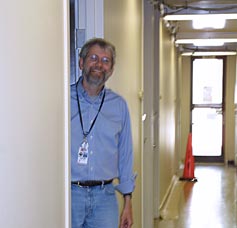
Handy Links
SLAC News Center
SLAC Today
- Subscribe
- Archives: Feb 2006-May 20, 2011
- Archives: May 23, 2011 and later
- Submit Feedback or Story Ideas
- About SLAC Today
SLAC News
Lab News
- Interactions
- Lightsources.org
- ILC NewsLine
- Int'l Science Grid This Week
- Fermilab Today
- Berkeley Lab News
- @brookhaven TODAY
- DOE Pulse
- CERN Courier
- DESY inForm
- US / LHC
SLAC Links
- Emergency
- Safety
- Policy Repository
- Site Entry Form

- Site Maps
- M & O Review
- Computing Status & Calendar
- SLAC Colloquium
- SLACspeak
- SLACspace
- SLAC Logo
- Café Menu
- Flea Market
- Web E-mail
- Marguerite Shuttle
- Discount Commuter Passes
-
Award Reporting Form
- SPIRES
- SciDoc
- Activity Groups
- Library
Stanford
Around the Bay
No More Bricks in the Wall

To make room for research and to eliminate a seismic hazard, crews are removing the 30-foot-tall wall that separates End Station B from the B-line Target Room. In all, they are taking out more than 500 tons of shielding material, including a 12 x 30-foot beam dump in the target room, as well as an old beam target and other equipment.
For safety, caution tape has prevented people and experiments in End Station B from coming within 15 feet of the unbraced, unbolted wall. Approximately 1,600 square feet of floor space will be freed up by the removal project.
As soon as the space is cleared, Building Manager and International Linear Collider (ILC) engineering physicist Richard Swent will begin installing prototype equipment for the ILC project. The test stands will include two modulators and two klystrons, including the Marx modulator designed and built at SLAC, and a unique "sheet-beam" klystron to be built in the Klystron and Microwave Department.
Rigging International, the contractor that worked on the FFTB removal project [http://today.slac.stanford.edu/feature/FFTB-phase2.asp] adjacent to End Station B, is using the 50-ton bridge crane inside the hall to lower 68 concrete blocks and steel shielding plates to the ground. The pieces average 15 tons each, with the heaviest at 37 tons. Conventional and Experimental Facilities is overseeing the hoisting and rigging and construction safety.
Many groups are involved in properly identifying, handling and storing radioactive materials and lead contamination, including Environment Safety & Heath's Radiation Protection and Environment Protection groups. The test accelerator in End Station B continues to run during the three-week removal project.
The 16-foot-thick wall shielded End Station B from the radiation produced in the days when the linear accelerator sent beams crashing into targets in the target room. The first particle physics experiment at SLAC used beam line one in the B Target Room, where Martin Perl searched for new particles in 1966 and 1967. Over the following 15 years, a variety of experiments took advantage of the target room's three beam lines and numerous targets that produced secondary beams.
—Heather Rock WoodsSLAC Today, August 9, 2007
Above image: Philip Bucksbaum in the PULSE Center's new hallway.